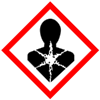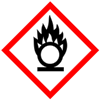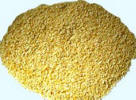Encapsulated Gel Breaker SDS MSDS Sheet |
| Mubychem Limited of USA & India is a pioneer manufacturers suppliers exporters & importers of chemicals including Hydraulic fracturing stimulation & oil well production chemicals, Pharmaceutical excipients, Fragrance & flavor chemicals. Muby Chem Ltd has several manufacturing facilities and toll manufacturers across the globe. We have offices warehouses and representatives in Houston & Midland Texas and Chicago Illinois USA. |
| Our suppliers have accreditations like FDA - GMP-GLP approval, ISO-9001, ISO-22000 HACCP, Kosher & Halal Certification. We offer Commercial Pure Pharmacopoeia Analytical Reagent & Food Grade of Chemicals and do Toll Manufacturing for Oil well drilling fracking fracturing and others. |
Encapsulated Gel Breaker Supplier's Specifications
Encapsulated Gel Breaker SDS MSDS Sheet Material Safety Data Sheet
1. Product Identification
CAS No.: Encapsulated Gel Breaker. It is a mixture of Ammonium
Persulfate coated with a polymer.
Intended Use: Oil & Gas Exploration. Breaking of Gaur Gum Gel in Oil well drilling fracking
or fracturing.
Molecular Weight: Not applicable
Chemical Formula: Not applicable
2. Composition/Information on Ingredients
| Name |
| Ammonium Persulfate CAS Number: 7727-54-0 Percentage: 70% to 90 Hazardous: Yes |
| Other Non-Haz Ingredients CAS Number: N/A Percentage: 10% to 30% Hazardous: No |
Signal Words: Warning
GHS, Globally Harmonized System Classification in accordance with 29 CFR 1910


Physical hazard: Oxidizer
Health hazards: May cause allergic
reaction upon repeated skin exposure. May cause allergic reaction upon
repeated inhalation exposure. Harmful if swallowed. May cause eye
irritation. May cause repiratory tract irritation. Causes irritation if
swallowed. May cause skin irritation.
Other Information/Precautions: Violent reaction in contact with
acids, reducing agents, organic materials, aluminum, copper. May ignite
combustible materials in contact with water or moist air. Explosive with
dry bromates.
Hazard Statements:
H272: May intensify fire; oxidizer
H302: Harmful if swallowed
H312: Harmful in contact with skin
H315 : Causes skin irritation
H317: May cause an allergic skin reaction
H320: Causes eye irritation
H335: May cause respiratory irritation
Precautionary Statements
P210: Keep away from heat/sparks/open flames/hot surfaces. - No smoking.
P220: Keep/Store away from clothing/other combustible materials
P221: Take any precaution to avoid mixing with combustibles.
P260: Do not breathe dust/fume/gas/mist/vapors/spray
P264: Wash ... thoroughly after handling
P270: Do no eat, drink or smoke when using this product
P280-Wear protective gloves/protective clothing/eye protection/face
protection
P305+P351+P338: IF IN EYES: Rinse cautiously with water for several minutes.
Remove contact lenses, if present and easy to do. Continue rinsing.
P314: Get Medical advice/attention if you feel unwell.
P330: If swallowed, rinse mouth
P337+P313: If eye irritation persists: Get medical advice/ attention.
P360: Rinse immediately contaminated clothing and skin with plenty of water
before removing clothes.
P402: Store in a dry place
P501: Dispose of contents/container in accordance with
local/regional/national/international regulations.
Carcinogenic Effects: Not available.
Mutagenic Effects: Not available.
Teratogenic Effects: Not available.
Developmental Toxicity: Not available.
The substance may be toxic to upper respiratory tract.
3. Hazards Identification
| Name |
| Ammonium Persulfate CAS Number: 7727-54-0 Percentage: 70% to 90 Hazardous: Yes |
| Other Non-Haz Ingredients CAS Number: N/A Percentage: 10% to 30% Hazardous: No |
4. First Aid Measures
Inhalation: Remove to fresh air. If not breathing, give artificial respiration. If breathing is difficult, give oxygen. Get medical attention.
Ingestion: If swallowed, Do not induce vomiting. Give large quantities of water. Never give anything by mouth to an unconscious person. Get medical attention
immediately.
Skin Contact: In case of contact, immediately flush skin with plenty of water for at least 15 minutes while removing contaminated clothing and shoes. Cover the
irritated skin with an emollient. Cold water may be used. Wash clothing & shoes before reuse. Get medical attention.
Eye Contact: Check for and remove any contact lenses. In case of contact, immediately flush eyes with plenty of water for at least 15 minutes. Cold water may be
used. Get medical attention.
5. Fire Fighting Measures
Fire: Ammonium Persulfate and Encapsulated Gel Breaker is not combustible, but substance is a strong oxidizer and its heat of reaction with reducing agents or
combustibles may cause ignition. Heating or contact with water releases oxygen which may intensify combustion in an existing fire.
Explosion: An explosion hazard when mixed with finely powdered organic matter, metal powder, or reducing agents.
Fire Extinguishing Media: Use any means suitable for extinguishing surrounding fire. Do not use water.
Special Information: In the event of a fire, wear full protective clothing and NIOSH-approved self-contained breathing apparatus with full face piece operated
in the pressure demand or other positive pressure mode. Sealed containers may rupture when heated.
6. Accidental Release Measures
Small Spill: Use appropriate tools to put the spilled solid in a convenient waste disposal container.
Large Spill: It is an oxidizing material.
Stop leak if without risk. Avoid contact with a combustible material (wood, paper, oil, clothing...). Keep the substance damp using water spray. Do not touch spilled
material. Prevent entry into sewers. Eliminate all ignition sources.
7. Handling and Storage
Keep Encapsulate Gel Breaker in a tightly closed container, stored in a cool, dry, ventilated area. Protect against physical damage. Isolate from incompatible substances. Separate from combustibles, organic or other readily oxidizable materials. Avoid storage on wood floors. Containers of this material may be hazardous when empty since they retain product residues (dust, solids); observe all warnings and precautions listed for the product.
8. Exposure Controls/Personal Protection
Airborne Exposure Limits:
- ACGIH Threshold Limit Value (TLV): 0.1 mg/m3 (TWA) as persulfate
Ventilation System: A system of local and/or general exhaust is recommended to keep employee exposures below the Airborne Exposure Limits. Local exhaust
ventilation is generally preferred because it can control the emissions of the contaminant at its source, preventing dispersion of it into the general work area.
Personal Respirators (NIOSH Approved): For conditions of use where exposure to dust or mist is apparent and engineering controls are not feasible, a particulate
respirator (NIOSH type N95 or better filters) may be worn. If oil particles (e.g. lubricants, cutting fluids, glycerin, etc.) are present, use a NIOSH type R or P
filter. For emergencies or instances where the exposure levels are not known, use a full-face positive-pressure, air-supplied respirator. WARNING: Air-purifying
respirators do not protect workers in oxygen-deficient atmospheres.
Skin Protection: Wear protective gloves and clean body-covering clothing.
Eye Protection: Use chemical safety goggles. Maintain eye wash fountain and quick-drench facilities in work area.
9. Physical and Chemical Properties
Appearance: Encapsulate Gel Breaker is white to off-white crystals
Odor: Mild organic odor
Solubility: Soluble
Specific Gravity: 1.75.
pH: No information found
Boiling Point: Not applicable
Melting Point: Decomposes
Vapor Density (Air=1): No information found
Vapor Pressure (mm Hg): No information found
Evaporation Rate (BuAc=1): No information found
10. Stability and Reactivity
Stability: It is stable under ordinary conditions of use and storage. Stability decreases in the presence of moisture
Hazardous Decomposition Products: Decomposed by moisture to form oxygen and ozone. Burning may produce nitrogen oxides, sulfur oxides, sulfuric acid,
chlorine or hydrochloric acid and fumes.
Hazardous Polymerization: Will not occur
Incompatibilities: Reducing agents, organic material, sodium peroxide, water and powdered metals especially aluminum
Conditions to Avoid: Moisture, combustible materials and incompatibles
11. Toxicological Information
Ammonium Persulfate
Oral rat LD50: 689 mg/kg
--------\Cancer
Lists\-- ------------------- -------------------
------------------------------- --NTP Carcinogen--
Ingredient -------------------- Known Anticipated IARC Category
------------------------------- ----- ----------- -------------
Ammonium Persulfate (7727-54-0) No -- No -------- None
12. Ecological Information
Environmental Fate: No information found.
Environmental Toxicity: No information found.
13. Disposal Considerations
Whatever cannot be saved for recovery or recycling should be handled as hazardous waste and sent to a RCRA approved waste facility. Processing, use or contamination of this product may change the waste management options. State and local disposal regulations may differ from federal disposal regulations. Dispose of container and unused contents in accordance with federal, state and local requirements.
14. Transport Information
Domestic (Land, D.O.T.)
-----------------------
Proper Shipping Name: Ammoniul Persulfate (Encapsulated)
Hazard Class: 5.1
UN/NA: UN1444
Packing Group: III
International (Water, I.M.O.)
-----------------------------
Proper Shipping Name: Ammoniul Persulfate (Encapsulated)
Hazard Class: 5.1
UN/NA: UN1444
Packing Group: III
15. Regulatory Information
The information below is for Ammonium Persulfate:
SARA Section 302 Extremely Hazardous Substances
None of the chemicals in this product have a TPQ.
SARA Codes
CAS # 7727-54-0: acute, reactive.
Section 313
No chemicals are reportable under Section 313.
Clean Air Act:
This material does not contain any hazardous air pollutants. This material does not contain any Class 1 Ozone depletors. This material does not contain any Class 2
Ozone depletors.
Clean Water Act:
None of the chemicals in this product are listed as Hazardous Substances under the CWA. None of the chemicals in this product are listed as Priority Pollutants under
the CWA. None of the chemicals in this product are listed as Toxic Pollutants under the CWA.
California No Significant Risk Level: None of the chemicals in this product are listed.
OSHA: Hazardous by definition of Hazard Communication Standard (29 CFR 1910.1200).
WHMIS (Canada):
CLASS C: Oxidizing material
Product Identification Number: 1444
Hazard Classification / Division: Class C (Oxidizer), Class D, Div. 2, Subdiv. B. (Toxic)
Ingredient Disclosure List: Listed
The polymer component is not classed as hazardous or toxic substance.
16. Other Information
Disclaimer:
******************************
Our company provides this Encapsulated Gel Breaker SDS sheet contained herein in good faith but makes no representation as to its comprehensiveness or accuracy.
This Encapsulated Gel Breaker MSDS sheet is intended only as a guide to the appropriate precautionary handling of the material by a properly trained person using this
product. Individuals receiving the information must exercise their independent judgment in determining its appropriateness for a particular purpose.
******************************
Suppliers Manufacturers Exporters Importers between USA Canada UAE Europe South Africa Tanzania Kenya Uganda Egypt Nigeria Turkey Mexico Brazil Argentina Chile Dubai China India etc.
Copyright and Usual Disclaimer is Applicable.
If you feed a dog with your hand, it will never bite you. That is the principal difference between a dog and a man.







